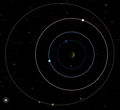Difference between revisions of "Jool/zh-cn"
(→Natural Satellites) |
m |
||
| Line 40: | Line 40: | ||
|} | |} | ||
| − | == | + | == 图集 == |
<gallery> | <gallery> | ||
| − | Jool_Descent.png | | + | Jool_Descent.png | 进入 Jool 大气层的探测器,最终由于高压损毁。 |
| − | Jool.png | | + | Jool.png | 0.17 里的 Jool。 |
| − | jool_and_moons.jpg | | + | jool_and_moons.jpg | 0.17 里的 Jool 和其卫星。 |
| − | Screenshot540.png | | + | Screenshot540.png | Jool 的低轨运行。 |
| − | screenshot73.png | | + | screenshot73.png | 带有控制小翼的探测器。Note that as you descend deeper into the atmosphere, it gets harder to move at all, rendering RCS and winglets useless. |
Screenshote4141412.png | A view of Laythe, Vall, and Tylo during an aerobraking on Jool. | Screenshote4141412.png | A view of Laythe, Vall, and Tylo during an aerobraking on Jool. | ||
19Aerobrake.jpg | A Probe aerobraking in Jool's atmosphere as of 0.19, With Laythe, Tylo, and Vall in the background. The aerobraking elapsed 15 minutes before the probe was destroyed. | 19Aerobrake.jpg | A Probe aerobraking in Jool's atmosphere as of 0.19, With Laythe, Tylo, and Vall in the background. The aerobraking elapsed 15 minutes before the probe was destroyed. | ||
Revision as of 08:25, 19 June 2013
Jool是一颗气态巨行星,是 Kerbol 星系中的第六颗行星。它实际上就是 Kerbal 太空计划中的木星。除 Kerbol 之外,在星系中所有天体中,Jool 的直径和质量都排名第一。虽然它距离 Kerbin 很远,难以到达,它还是由于其自身复杂的五卫星体系成为极具吸引力的航天探索目标,它的五颗卫星包括:Laythe、Vall、Tylo、Bop和Pol。
Atmosphere
|
Although Jool has a radius ten times greater than Kerbin, its atmosphere begins just twice as high (138.2 km). It is extremely dense, well suited for aerobraking from a high-speed interplanetary intercept. Orbiting just outside the atmosphere will give you a period of 94.7437 minutes, and a speed of 6,785 m/s. You typically do not need to go lower than 100 km to aerobrake. In general, the atmospheric pressure on Jool at an altitude expressed in meters is: Closer to the surface, the physics of the game start to break down. Due to its extremely thick atmosphere, terminal velocity is so low that lighter spacecraft will not even need parachutes or retrorockets. It is not impossible to land on its solid surface, though spacecraft are inevitably and invariably devoured by the Kraken. If the craft is very small, it may survive the Kraken, but the parts will explode once they are 100m below the surface. The message "... collided with Cloud" will display in the mission summary. If a Kerbonaut is put on EVA he will not be destroyed, making one-way sacrificial landings possible. However, as seen near the end of this video, the Kerbonaut will start to glitch out and shake uncontrollably. This only happens if you're on time warp 4. The game will later glitch and cut to a black screen with the altimeter going through numbers rapidly. Unless you restart the game, Kerbin's atmosphere will be missing. |
时间加速
| 时间加速 | 最低海拔 |
|---|---|
| 1× | 所有 |
| 5× | 200 000 米 (高于大气上限) |
| 10× | 200 000 米 (高于大气上限) |
| 50× | 200 000 米 (高于大气上限) |
| 100× | 200 000 米 (高于大气上限) |
| 1 000× | 300 000 米 |
| 10 000× | 600 000 米 |
| 100 000× | 1 200 000 米 |
天然卫星
 大片海洋覆盖的月亮,Laythe,我们即将观察到它的凌 Jool 现象。 Jool 有五颗天然卫星,每个卫星的轨道平面都和 Jool 自身的轨道平面相重合:
Laythe、Vall 和 Tylo 三者的轨道符合拉普拉斯共振,轨道周期比为 1:2:4 。尽管理论上说在这种状态下,各卫星与 Jool 彼此易出现“蚀”现象,现实是没有,它们在轨道上运行的秋毫无犯。 Jool 卫星的同步轨道是不存在的,因为理论的轨道已经处于各个卫星的引力作用球体范围之外,这是同步自传天体常见的现象。 |
图集
- Screenshot540.png
Jool 的低轨运行。
- Screenshot73.png
带有控制小翼的探测器。Note that as you descend deeper into the atmosphere, it gets harder to move at all, rendering RCS and winglets useless.
- Screenshote4141412.png
A view of Laythe, Vall, and Tylo during an aerobraking on Jool.
Trivia
- Jool has roughly the same equatorial radius as the planets Earth and Venus.
- The sunsets and sunrises on Jool are a shade of yellowish brown.
- Like Jool, Jupiter's nearest three moons (Io, Europa, and Ganymede) have a Laplace resonance of 1:2:4.
Changes
- Added a new, more distant moon named Pol.
- Initial Release







